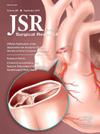早期姑息治疗对接受癌症手术的高危患者的影响。
IF 1.7
3区 医学
Q2 SURGERY
引用次数: 0
摘要
最近的两项临床试验对接受非姑息性手术治疗腹部恶性肿瘤的患者发现,早期专科姑息性干预没有任何益处。然而,更多的高危患者可能从这种干预中受益。方法:对其中一项试验的数据进行二次、事后的探索性分析,检验治疗效果的异质性,以确定受益于早期专科姑息治疗干预的高危亚组患者。采用治疗与患者报告结果(PROs)的年龄、虚弱程度和基线值之间相互作用的回归模型,检验5例PROs术后90 d治疗效果的异质性。结果:在alpha = 0.2时,有证据表明六个模型的治疗效果可能存在异质性:按年龄划分的身体和功能生活质量(P = 0.12)、焦虑(P = 0.03)和抑郁(P = 0.01);生理和功能生活质量(P = 0.04)、焦虑(P = 0.19)和生活空间(P = 0.03)的基线PRO值。图形检查并没有显示出对高危患者更积极干预效果的一致模式。结论:我们没有发现效果异质性的一致模式,表明一个特定的亚组受益于早期专科姑息治疗干预。这进一步支持了这样的结论,即这些患者的姑息治疗需求是由他们的常规护理团队满足的。本文章由计算机程序翻译,如有差异,请以英文原文为准。
Effects of Early Palliative Care Involvement on More At-Risk Patients Undergoing Surgery for Cancer
Introduction
Two recent clinical trials of patients undergoing nonpalliative surgery for abdominal malignancies found no benefit from early specialist palliative intervention. However, more at-risk patients may benefit from this intervention.
Methods
This secondary, post-hoc exploratory analysis of data from one of these trials examines heterogeneity of treatment effect to identify at-risk subgroups of patients who benefit from early specialist palliative intervention. Regression models with interaction terms between treatment and age, frailty, and baseline values of patient reported outcomes (PROs) were used to examine heterogeneity of treatment effect for five PROs at 90 d postoperatively.
Results
At alpha = 0.2, there was evidence of possible heterogeneity of treatment effect in six models: by age for the outcomes of physical and functional quality of life (P = 0.12), anxiety (P = 0.03), and depression (P = 0.01); by baseline PRO value for the outcomes of physical and functional quality of life (P = 0.04), anxiety (P = 0.19), and life space (P = 0.03). Graphical examination did not reveal a consistent pattern of more positive intervention effects for more at-risk patients.
Conclusions
We found no consistent pattern in heterogeneity of effect to suggest a particular subgroup benefitting from early specialist palliative intervention. This further supports the conclusion that the palliative care needs of these patients are met by their usual care teams.
求助全文
通过发布文献求助,成功后即可免费获取论文全文。
去求助
来源期刊
CiteScore
3.90
自引率
4.50%
发文量
627
审稿时长
138 days
期刊介绍:
The Journal of Surgical Research: Clinical and Laboratory Investigation publishes original articles concerned with clinical and laboratory investigations relevant to surgical practice and teaching. The journal emphasizes reports of clinical investigations or fundamental research bearing directly on surgical management that will be of general interest to a broad range of surgeons and surgical researchers. The articles presented need not have been the products of surgeons or of surgical laboratories.
The Journal of Surgical Research also features review articles and special articles relating to educational, research, or social issues of interest to the academic surgical community.

 求助内容:
求助内容: 应助结果提醒方式:
应助结果提醒方式:


